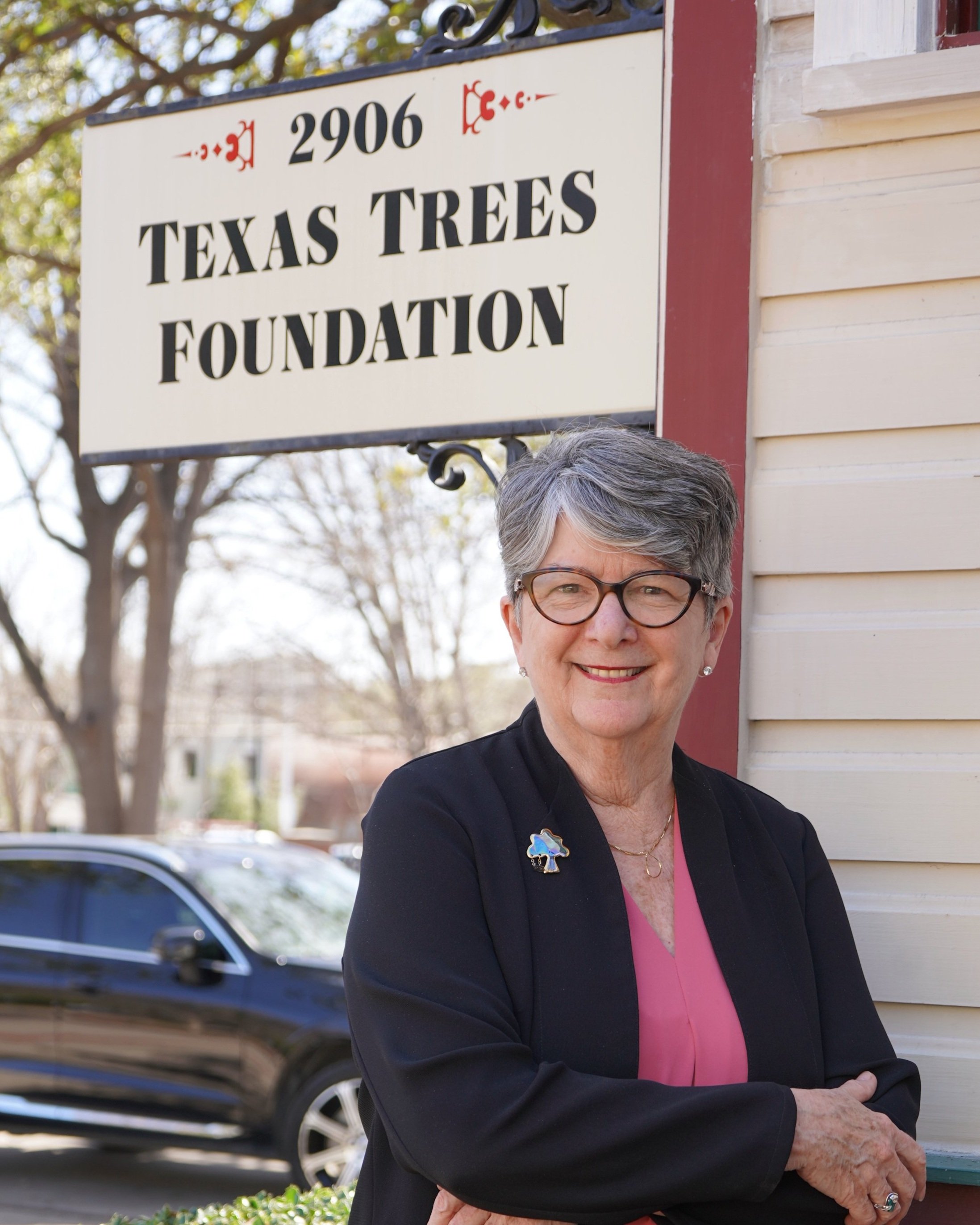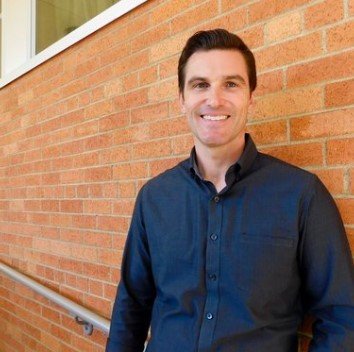Story by Mary King-Moore. Photos by Jan Osborn.
Since 1982, Texas Trees Foundation’s mission has been to preserve, beautify, and expand parks and other public natural green spaces in Dallas and surrounding areas. What started as a small organization to simply plant trees has expanded over the years to include a research division, school programs, and urban tree farms. Over the years, the Foundation has merged and collaborated with several other organizations, like Treescape/Dallas, which has led to greater impact and organizational growth.
We caught up with Janette Monear, current President & CEO and she shared what the Foundation is rooted in now. “One of the things I learned very quickly when I came to Dallas is that you have to have some strategy to move things forward, especially in 2007,” says Janette. “I came to Dallas from Minneapolis and I will tell you, working in Dallas, there is a can-do entrepreneurial spirit that I’ve never seen in any other city like it.”

Janette began her career in Iowa as vice president of advertising and promotion for a large bank. She was part of the team that implemented the second electronic banking center in the country. She moved to Minneapolis with her husband who was transferred for work. Janette began volunteering at the University of Minnesota. She was soon hired by Dr. David French, a world-renowned plant pathologist, to help with fundraising. She used her marketing and promotional background and was able to raise an impressive amount of funds for his department at the national level. “Dr. French taught me everything I know about forestry,” she recalled with a laugh, “and I raised a lot of money for him.”
From there, a nonprofit that had a workforce program invited her to create their urban forestry program. Janette reflected that her interest in forestry actually started at a very young age. Her mother started a nature center in the 1950s. She always enjoyed fishing and field trips as an adolescent. “What my parents did was plant the seed that we are connected to nature and we need that connection,” says Janette. Passionate about nature, in particular, tree canopy, Janette says that the role at the Foundation is one she loves.
Photo courtesy of Texas Trees Foundation.
The strategic plan for the Foundation she helped develop is committed to the future. As a visionary, Janette has made sure the organization considers not only urban development, but also the social and health benefits that trees provide. “I figured out early if we were going to move our programs forward we really needed the data. And we really needed not to just be plopping trees in the ground, but to really strategically focus on moving urban forestry forward in the city of Dallas, and then taking that model and moving it to other cities throughout North Texas.”

Photo courtesy of Texas Trees Foundation.
The research is what has given the organization integrity, and also has been able to amplify the need by quantifying the value of the urban forest. The Foundation launched several studies, including one of the first studies in the nation on urban heat island mitigation. One study showed Dallas with only 28% tree canopy. The USDA Forest Service recommends a minimum of 35%.
The need to increase tree canopy to lower the ambient air temperatures all over has led to several ongoing projects. One of the hottest areas in the city is the Southwest Medical District. Even though the physical institutions are in good shape, the areas outside are one of the least healthy spaces in Dallas. The Foundation launched a program to redesign the streetscapes of the Medical District. “It’s about a $200 million dollar project by the time we’re done, but it’s going to transform the district not only in terms of the environment but also the quality of life for the people in that area,” says Janette.

Another project Janette is really proud of is the Cool Schools program. This program has been part of the Foundation since the late 1980s. It was originally inspired by Trammell Crow, who had partnered with other nonprofits to establish programs for schools to have trees planted on their campuses. The research they are doing is showing how important these programs are to improving human health. “We know at a very deep level the work we are doing is actually physically, socially, emotionally, and spiritually improving people’s health,” says Janette.
With the urban heat island research, it was decided by the Foundation that more could be done in addition to planting trees. The Foundation is now educating members of the community about the importance of trees with a health and wellness component. The Cool Schools program transforms school campuses into outdoor environmental learning areas. Recently, the Foundation identified 40 schools that were in need of parks within a 10-minute walk of the neighborhood. A partnership with DISD and Dallas Parks and Recreation has created the opportunity to add new playground equipment at local parks and park expansion.
“These schools are fabulous!” says Janette. “They have a quarter-mile trail, new playgrounds, and Earth learning areas. There is also a curriculum that is STEM-focused. What we are finding is that the students have less stress and a place that is safe.” The Foundation has completed 20 schools and is currently fundraising for the next 20.
Another exciting program the Foundation is working on is the Living Lab. In fact, the Foundation has hired several research specialists to create this project. The purpose of the Living Lab is to continue research on the effects of urban forests on mental wellness, air quality, and how programs can be designed in different communities to incorporate more trees. They have partnered with Texas A&M, SMU, and the University of Virginia to research and design areas within cities with trees and plant materials. Janette sees the benefits the Living Lab can provide. She sees the research as an important part of the Foundation strategy and being able to articulate the results to the public so everyone knows what actions to take. The data from the research quantifies the environmental aspects of energy conservation and CO2 sequestration. “It gives relevance rather than just ‘trees are good’,” says Janette. “Trees are necessary.”

Photo courtesy of Texas Trees Foundation.
In September, the Foundation will host a 40th-anniversary celebration. The plan is to reinvigorate a park, though the location has yet to be decided. It will be a day-long event, recognizing the people and groups that have helped the Texas Trees Foundation grow to what it is today. Following the Foundation’s motto, “The greening of North Central Texas,” Janette and the Foundation are committed to trees and the quality of life they help provide.
Want to get involved? The Texas Trees Foundation has tree-planting volunteer activities throughout the year. The Foundation has planted over 1,800 trees in the past year and has distributed over 2,300 from their tree farm. Janette says that an easy way to help the organization is simply looking around your neighborhood and asking yourself, “Where are trees needed?”
To learn more about Texas Trees Foundation, go to www.texastrees.org.
Featured
more good stories
Featured
Josh Taylor was deployed to the Middle East, flying missions into Iraq, Afghanistan, and Syria, when he realized that many of the people he spoke to were divided. It was 2018, and Josh had already been in the Armed Forces for over ten years, but he wanted to find a cause that could unite the nation. “Flying 65,000 miles and spending 300 hours in a machine gives somebody a moment to think,” Josh says. Eventually, he found his answer– our youth, and alongside them, our educators– have the strength to be the foundation for our country.
When Lisa Wong launched the STEM program at Trinity Christian Academy, her goal and passion was to teach the kids that they can use STEM fields to bless others in the world around them. She views her time as an investment in the future.




